Browsing different alternatives online, I was looking for a new Brooklyn experience. I wanted to do an activity involving fresh air and the peace and quiet of nature, as much as allowed by living in the largest city in the U.S.
Luckily Prospect Park, Brooklyn’s giant 585-acre lung, offers plenty of fun from horseback riding to nature walks throughout the fall.
I opted for Brooklyn Bird Club’s (BBC) birdwatching tours. Every Tuesday, Thursday and Saturday morning, a knowledgable guide will lead you through the best birdwatching spots in the park, starting from various entrances. The walks run throughout September, which is migration season, and will be replaced from October and onwards by monthly Sunday walks. Weekly beginner walks continues Saturdays at noon.
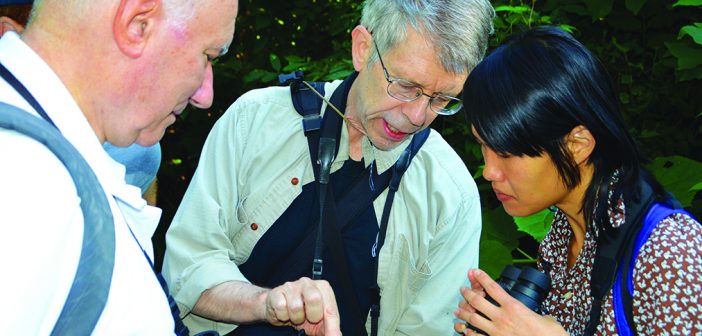
I have very little previous experience of birdwatching. In fact, my whole experience consists of one single birdwatching excursion during my childhood in Sweden. Because the days are so long during summer, we had to get up at 3am to catch the sunrise, which is when the birds are the most active. I remember the excitement of being up that early, and allowed out in the middle of the night. I also remember the deafening cacophony of what must have been thousands of birds singing their tunes in the magic hour of dawn. I absorbed this new, secret world of sounds in awe, feeling like I’ve entered some kind of a parallel universe.
What I don’t remember, however, is seeing any birds. Perhaps a guided tour under Tom Stephenson’s competent leadership would ensure a visual birdwatching experience this time? At 7:15am on Thursday, August 25, we met at the Grand Plaza entrance of Prospect Park, along with a group of about 12 enthusiastic birdwatchers. Tom kindly lent me a pair of binoculars, and having been briefed about my lack of experience, offered some insights to what we were about to experience.
Apparently, Prospect Park, despite being crammed in between urban concrete, is a birdwatching heaven. Home to over 200 species, an impressive 40-100 species can be spotted in one single walk, although you’re more likely to hit the higher numbers in the spring. One reason for the abundance of birdlife, is that the general westerly component of winds in the U.S. tend to push migrating birds towards the east coast. Since they will resist flying over water, their flight path is often concentrated along the eastern shoreline.
Urban areas without parks offer no place to rest and recharge, which the birds are dependent on, to survive their long journeys. They need the right kinds of shelter and feeding environments, where they can stay for several days to gain enough body fat to continue or recover from their long journey. Sadly, urban areas by the sea without parks become death traps for migrating birds, especially if there are many feral cats.
Prospect Park is one of New York’s 130 Important Bird Areas (IBA) critical for bird conservation, and harbors some species unusual enough to create headlines (in birdwatching circles). Three years ago, the first Brooklyn-nesting Ruby-throated Hummingbird was documented by BBC, although the birds you are likely to spot most frequently are American Robins, European Starlings, Northern Cardinals and House Sparrows. But with Tom being not only an avid birdwatcher, but also the distinguished author of The Warbler Guide, which won the 2014 National Outdoor Book Award in Nature Guidebooks, we set out to find the Warblers.
We walked at a slow pace, and I had the chance to chat a bit with my fellow birdwatchers, who turned out to be a very friendly and welcoming bunch. Many were regulars, and most of them locals, but some were tourists just briefly visiting. Rachel Ramaker, a Dutch girl living in England, had brought her binoculars for the opportunity to birdwatch. In fact, since a set of binoculars is all you need, birdwatching is a great hobby to bring along when traveling. It’s easy to join local networks for a chance to spot new species, although Rachel turned out to be a frequent visitor, as well informed as the locals. Charmed by Park Slope, she said she kept meticulous track of local happenings through the Park Slope Reader.
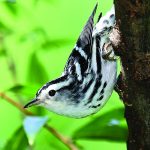
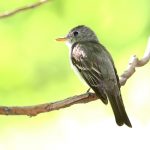
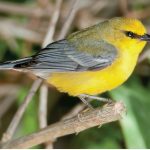
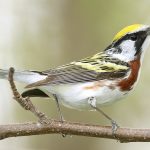
It didn’t take long before we spotted our first birds. Well, to be accurate, it didn’t take long before the group started to see Starlings, Robins, and Cardinals. I couldn’t see anything but blurry leaves, and was surprised to learn that using binoculars requires a bit of a technique. You have to look at one spot, and bring the binoculars up while still looking, Tom instructed, rather than trying to find the spot by circling around with the binoculars.
To me, Tom gave the impression of a bird whisperer. He whistled, they answered, and we watched. He could hear if it was young birds, not yet able to sing as well as their parents, and explained that baby birds deprived of hearing their parents sing will never be able to learn it well later. Some species will even loose the ability completely and sing songs that would be unrecognizable by their own species, making it unlikely for them to ever be able to breed. It’s mainly the male birds who sing in Prospect Park, I learnt, as opposed to the birds in tropical forests, where both males and females sing. This is because tropical birds don’t migrate, so both males and females have to help out defending their territory.
When we got to the lake, Wood Ducks were peacefully gliding by. I learnt that they are the only duck with claws, which they use to climb up high trees, to nest in holes, like owls. The trees help them avoid predators, and at least two pairs of Wood Ducks have successfully raised their young in Prospect Park this season. The list of spotted birds kept growing, and would eventually come to include Double-crested Cormorant, Canada Goose, Mute Swan, Wood Duck, Mallard, Northern Shoveler, Spotted Sandpiper, Rock Dove, Mourning Dove, Chimney Swift, Ruby-throated Hummingbird, Red-bellied Woodpecker, Downy Woodpecker, Northern Flicker, Eastern Wood-Pewee, Eastern Kingbird, Warbling Vireo, Red-eyed Vireo, Blue Jay, Barn Swallow, Tufted Titmouse, Red-breasted Nuthatch, White-breasted Nuthatch, Veery, American Robin, Gray Catbird, European Starling, Cedar Waxwing, Blue-winged Warbler, Yellow Warbler, Chestnut-sided Warbler, Black-throated Green Warbler, Black-and-white Warbler, American Redstart, Northern Waterthrush, Common Yellowthroat, Northern Cardinal, Common Grackle, Baltimore Oriole, House Finch, American Goldfinch and House Sparrow.
An impressive 42 birds were spotted while I practiced maneuvering my binoculars. But it wasn’t in vain. Eventually, I managed to focus on a movement in the leaves, and soon a… wait, could it be… yes, a Blue-Winged Warbler emerged and strutted about in the sun for quite some time, as if to reward me for my struggles, before disappearing back into the leaves. I was surprised at the thrill I felt of getting so close visually to the delicate Warbler.
Will I do it again? Probably! Birdwatching is a great recreational outdoor activity, and the slow pace makes it suitable for all fitness levels. Even I, with a broken ankle in a boot, had no trouble keeping up. My advice to the first timer would be to start with the Saturday beginner walks in the winter, when there are no leaves in the way. Also, this is not the right target group for cute cat stories. Cats are the number one bird killer. Don’t mention your cat!
——
To do: www.prospectpark.org/visit-the-park/things-to-do
Birdwatching: www.prospectpark.org/visit-the-park/things-to-do/birdwatching
Tom’s book on Warblers: press.princeton.edu/titles/9968.html
Goats: www.prospectpark.org/news-events/news/return-goats
BBC: www.brooklynbirdclub.org
Schedule: www.brooklynbirdclub.org/trips.htm
All bird images courtesy of Tom Stephenson
Featured image and image of Tom Stephenson courtesy of Annika Andersson
